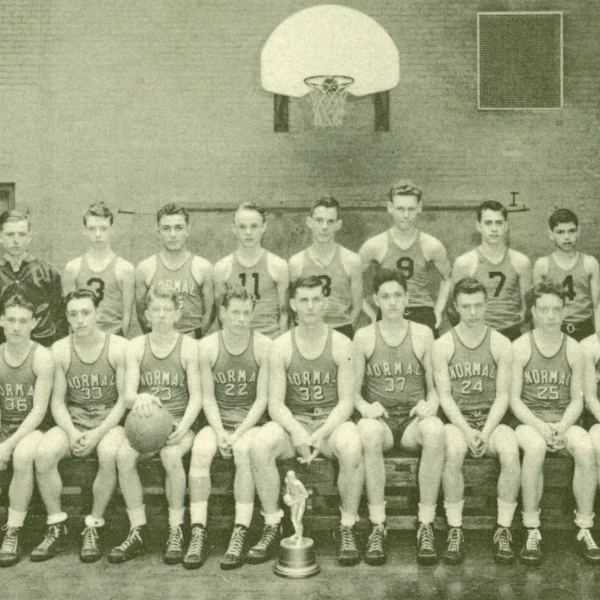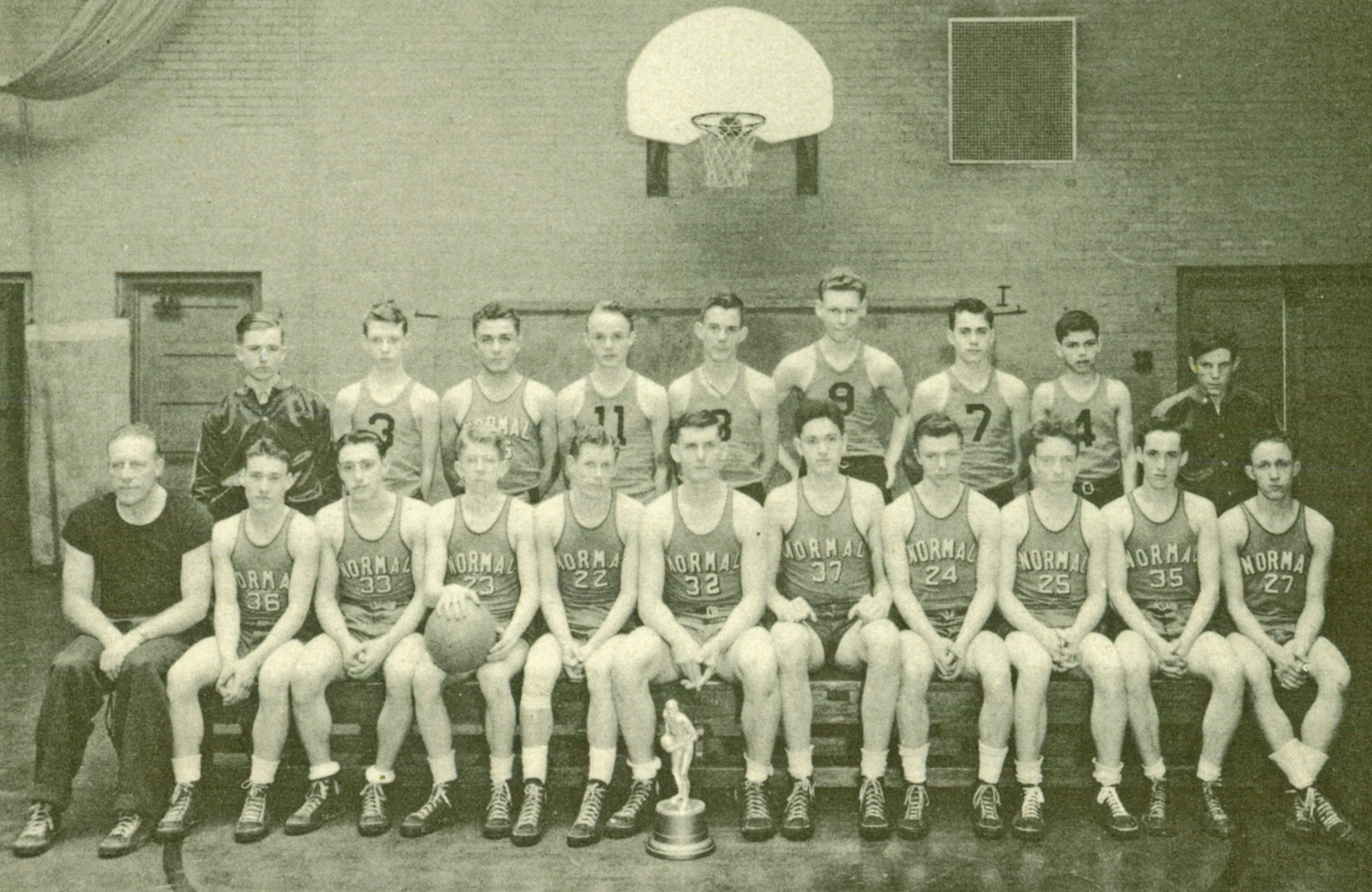Three months after Pearl Harbor and the U.S. entry into World War II, Normal residents found their attention momentarily turned to an undersized but tough-as-iron Normal Community High School boys’ basketball team as they made a deep run in the state tournament.
Although a surprising “sweet sixteen” appearance in Champaign capped the 1941-42 season, the team didn’t catch fire until state tourney time. NCHS finished the regular season with 10-11 record, only to rattle off six straight wins to capture regional and sectional championships.
They lost their one game at storied Huff Gymnasium on the University of Illinois campus, but the 16-12 “little” Ironmen headed back to the Twin Cities on Highway 150 with their heads held high, having made history with the school’s first appearance in the state basketball finals.
“My main memory is the size of that team was amazing,” recalled Ed Alsene to Pantagraph reporter Douglas Hamm in a 2005 story on the 1941-42 season. “Their so-called forwards were 5-6 and 5-5 … That’s got to be the smallest team to ever play in Huff Gym in the state finals.” Back then, Alsene was one year out of NCHS and covering his alma mater as a sportswriter for The Pantagraph.
The Ironmen, though quick and athletic, were often worn down by taller opponents. When they lost to Dwight 44-33 on Dec. 17, for instance, they spotted the visiting Trojans nearly six inches a man.
Normal Community High itself was also small, at least enrollment-wise. At this time, NCHS competed in the Corn Belt Conference with U High, Pontiac, and others, and not in the Big 12 with the likes of Bloomington and the big city schools of Peoria. The Ironmen were coached by Ralph “Hap” Arends, who went on to serve as McLean County schools superintendant for nearly a quarter century.
The “Orange and Black’s” leading scorer and most valuable player was forward Don “Andy” Anderson. Though standing 5-8, his speed and court smarts were something to see. Anderson picked up 15 varsity letters at NCHS, and it’s said he played a little football at both the U of I—all 128 pounds of him—and Illinois Wesleyan.
The blonde junior patterned his high-arching, two-handed “kiss shot” after Centralia’s hard court wizard (and later Illini legend) Dwight “Dike” Eddleman. The year before, Anderson and a group of Normal boys drove all the way to Centralia to see the great Eddleman in a state tourney quarterfinal. “They put the ball right up at their nose and shot a two-handed shot,” is how Alsene described it.
Anderson finished the year tops in Corn Belt scoring, becoming in the process Normal’s single-season points producer.
It was a seesaw season featuring a handful of furious comebacks which, more often than not, came up short, such as a 47-42 overtime loss on Feb. 10 at the hands of non-conference opponent Peoria Manual.
The team’s resilience and toughness was perhaps best exemplified in the play of 5-5 freshman forward Jimmy Melton, who spent his childhood at Victory Hall, a boys’ home in Normal (today the building is home to an ISU fraternity). It’s believed several other 1941-42 Ironmen were from Victory Hall.
Intercity schools—NCHS, Bloomington, U High and Trinity (now Central Catholic)—used to play everyone else twice each season. The Ironmen lost both times to much-larger and Big 12 member BHS, whose lineup included brothers “Bump” and Pete Elliott. Both boys ended up playing and coaching football in the Big Ten, with Bump serving as University of Michigan’s head coach from 1959 to 1968, and Pete becoming an all-American quarterback with the Wolverines and coaching at the U of I.
Slippery speedster Anderson and his fellow Ironmen, though, swept fellow Corn Belt member U High, while splitting two games with evenly matched Trinity. On Feb. 13, they lost 35-31 at “The Pit,” the sorely missed bandbox of a gym at the Catholic school’s former Center Street location.
The regular season ended for NCHS on Feb. 27 with a disappointing 48-47 loss to the Don Cooke and Harlan Otto-led Danvers Dragons. Redemption, though, was right around the corner as the Ironmen had all their furnaces firing in lopsided victories over Chenoa, El Paso and U-High to capture the regional crown.
At the Peoria Sectional, the “mighty mites” of Normal got their revenge over Peoria Manual, and then out-battled Havana in thrilling fashion to meet East Peoria in the Mar. 13 sectional championship. It was an honest-to-goodness barnburner, as Anderson swished a 30-footer with 25 seconds left for a 37-36 victory, punching the Ironmen’s ticket to Champaign and a Mar. 19 state finals appearance at Huff Gym.
NCHS had the second smallest enrollment (468 students) of the schools in the “sweet sixteen” that year (the state finals would be pared to the “elite eight” in 1956.) The 1942 field included Centralia, Chicago Lindblom, Freeport, Olney and Quincy, among others.
Alas, the Ironmen’s magical postseason run ended with a decisive 45-34 loss to “towering” Big 12 champion Streator Township, which at the time had an enrollment of 1,100. Two forwards for the Bulldogs, Ben Kristal and Don Morris, were too big and athletic for overmatched NCHS. “Andy” Anderson managed only ten points, with six of those coming at the charity stripe. “The Streator boys handled him rather roughly at times,” The Pantagraph couldn’t help but coolly observe.
For those keeping score at home, Centralia, led by Dike Eddleman, beat Paris 35-33 to claim the school’s third state championship.
Most of Ironmen served in World War II. Team captain Jim Pemberton, for example, fought with the 103rd Infantry Division in Europe, receiving the Bronze Star for heroism under fire. Dale Steege, a 6-2 center, fought in the South Pacific with the Marines, while Jim Melton, the Victory Hall kid, served in the Navy (unfortunately, space prohibits a full accounting of the 1941-42 roster.)
Once back in Central Illinois, Pemberton sold furniture and then insurance, and found time to serve on the McLean County Board and become a charter member of the Heartland Community College Board. He passed away in 2002. Steege was a plumber and strong union man living on East Locust Street in Bloomington at the time of his death in 1990. Melton put in 22 years at Firestone Tire and Rubber Co., dying in 2008.
What better way to end a wonderful story like this but with another wonderful story. “Hap coached all the major sports, but he focused on football and track,” Ed Alsene recalled of Normal’s head coach Hap Arends. “When he saw Anderson and this group coming in, he went out and bought a basketball coaching book and got more serious about it.”

